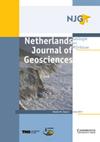An overview of fault zone permeabilities and groundwater level steps in the Roer Valley Rift System
IF 2.3
2区 地球科学
Q3 GEOSCIENCES, MULTIDISCIPLINARY
Netherlands Journal of Geosciences-Geologie En Mijnbouw
Pub Date : 2019-01-01
DOI:10.1017/njg.2019.4
引用次数: 6
Abstract
Abstract Faults in the Roer Valley Rift System (RVRS) act as barriers to horizontal groundwater flow. This causes steep cross-fault groundwater level steps (hydraulic head differences). An overview of the size and distribution of fault-related groundwater level steps and associated fault zone permeabilities is thus far lacking. Such an overview would provide useful insights for nature restoration projects in areas with shallow groundwater levels (wijstgronden) on the foot wall of fault zones. In this review study, data on fault zone permeabilities and cross-fault hydraulic head differences were compiled from 39 sources of information, consisting of literature (starting from 1948), internal reports (e.g. from research institutes and drinking water companies), groundwater models, a geological database and new fieldwork. The data are unevenly distributed across the RVRS. Three-quarters of the data sources are related to the Peel Boundary Fault zone (PBFZ). This bias is probably caused by the visibility of fault scarps and fault-adjacent wet areas for the PBFZ, with the characteristic iron-rich groundwater seepage. Most data demonstrate a cross-fault phreatic groundwater level step of 1.0 to 2.5 m. Data for the Feldbiss Fault zone (FFZ) show phreatic cross-fault hydraulic head differences of 1.0 to 2.0 m. In situ measured hydraulic conductivity data (K) are scarce. Values vary over three orders of magnitude, from 0.013 to 22.1 m d−1, are non-directional and do not take into account heterogeneity caused by fault zones. The hydraulic conductivity (and hydraulic resistance) values used in three different groundwater models are obtained by calibration using field measurements. They also cover a large range, from 0.001 to 32 m d−1 and from 5 to 100,000 days. Heterogeneity is also not taken into account in these models. The overview only revealed locations with a clear cross-fault groundwater level step, and at many locations the faults are visible on aerial photographs as cropmarks or as soil moisture contrasts at the surface. Therefore, it seems likely that all faults have a reduced permeability, which determines the size of the groundwater level steps. In addition, our results show that cross-fault hydraulic head gradients also correlate with topographic, fault-induced offsets, for both the Peel Boundary and the Feldbiss fault zone.罗尔谷裂谷系断裂带渗透率和地下水位阶跃的概述
罗尔谷裂谷系统(RVRS)中的断层是地下水水平流动的屏障。这导致了陡峭的跨断层地下水位台阶(水头差)。迄今为止,对断层相关的地下水位阶跃的大小和分布以及相关的断裂带渗透率的概述还很缺乏。这样的概述将为断裂带下壁地下水位较浅的地区(wijstgronden)的自然恢复项目提供有用的见解。在这项综述研究中,断层渗透率和断层间水头差异的数据来自39个信息来源,包括文献(从1948年开始)、内部报告(如研究机构和饮用水公司)、地下水模型、地质数据库和新的实地调查。数据在RVRS中分布不均匀。四分之三的数据源与皮尔边界断裂带(pbz)有关。这种偏倚可能是由于断裂带内断层陡坡和断层邻近湿区明显可见,具有富铁地下水渗流特征。大多数资料表明,跨断层潜水地下水位步长为1.0 ~ 2.5 m。feldiss断裂带(FFZ)的数据显示,断层间的潜水水头差异为1.0 ~ 2.0 m。现场测量的水力传导率数据(K)很少。数值变化超过三个数量级,从0.013到22.1 m d - 1,是无方向性的,没有考虑到断层带引起的非均质性。在三种不同的地下水模型中使用的水导率(和水阻)值是通过现场测量校准得到的。它们还涵盖了很大的范围,从0.001到32 m d - 1,从5到100,000天。这些模型也没有考虑异质性。该概览仅显示了具有明确的跨断层地下水位阶梯的位置,并且在许多地方,断层在航空照片上作为作物标记或地表土壤湿度对比可见。因此,似乎所有断层的渗透性都降低了,这决定了地下水位台阶的大小。此外,我们的研究结果表明,对于Peel边界和Feldbiss断裂带来说,跨断层水头梯度也与地形、断层引起的偏移有关。
本文章由计算机程序翻译,如有差异,请以英文原文为准。
求助全文
约1分钟内获得全文
求助全文
来源期刊
CiteScore
4.00
自引率
25.90%
发文量
14
审稿时长
>12 weeks
期刊介绍:
Netherlands Journal of Geosciences - Geologie en Mijnbouw is a fully open access journal which publishes papers on all aspects of geoscience, providing they are of international interest and quality. As the official publication of the ''Netherlands Journal of Geosciences'' Foundation the journal publishes new and significant research in geosciences with a regional focus on the Netherlands, the North Sea region and relevant adjacent areas. A wide range of topics within the geosciences are covered in the journal, including "geology, physical geography, geophyics, (geo-)archeology, paleontology, hydro(geo)logy, hydrocarbon exploration, modelling and visualisation."
The journal is a continuation of Geologie and Mijnbouw (published by the Royal Geological and Mining Society of the Netherlands, KNGMG) and Mededelingen Nederlands Instituut voor Toegepaste Geowetenschappen (published by TNO Geological Survey of the Netherlands). The journal is published in full colour.

 求助内容:
求助内容: 应助结果提醒方式:
应助结果提醒方式:


